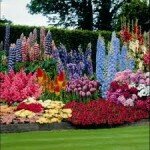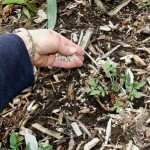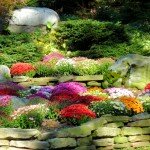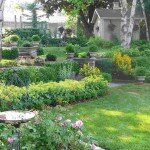KNOWLEDGE TO GROW
 by Karen Weiland, Purdue Master Gardener
by Karen Weiland, Purdue Master Gardener
Fertilizer supplies your plants with mineral nutrients which are “fed” to the plant through the soil Plants growing in soils that do not contain all the necessary minerals show nutritional deficiency symptoms such as yellow leaves, floppy stems and brown leaf margins.
Most perennials are not traditionally heavy feeders. They do not have as high a demand for  fertilizer as say your lawn does. Feeding too much nitrogen often causes lush foliage and fewer flowers. Depending on the make- up of your soil, most perennials benefit from a single fertilizer application just before or at the time that new spring growth appears. It is generally recommended to apply no more than 1 pound of nitrogen per 1000 square feet. Just as a comparison, this is about one fourth of what you may use on your lawn during a growing season. It is better to apply too little fertilizer rather than too much. You can always add more if need be.
fertilizer as say your lawn does. Feeding too much nitrogen often causes lush foliage and fewer flowers. Depending on the make- up of your soil, most perennials benefit from a single fertilizer application just before or at the time that new spring growth appears. It is generally recommended to apply no more than 1 pound of nitrogen per 1000 square feet. Just as a comparison, this is about one fourth of what you may use on your lawn during a growing season. It is better to apply too little fertilizer rather than too much. You can always add more if need be.
Broadcasting a slow-release granular product is the recommended choice for meeting the perennials season-long nutrient requirements. If you use the “side-dress” method of  fertilizer application, apply the manufacturer guideline amount at the general root zone of each plant. Do not allow the fertilizer granules to cluster at the crown of the plant or linger on the leaves as it may cause burning. If you apply fertilizer in the very early spring the cool temperature of the soil can have an effect on the uptake of certain nutrients in the soil that makes the foliage appear light green to yellow. If this discoloration does not go away as the season progresses, spot treat with a shot of liquid feed to green it up.
fertilizer application, apply the manufacturer guideline amount at the general root zone of each plant. Do not allow the fertilizer granules to cluster at the crown of the plant or linger on the leaves as it may cause burning. If you apply fertilizer in the very early spring the cool temperature of the soil can have an effect on the uptake of certain nutrients in the soil that makes the foliage appear light green to yellow. If this discoloration does not go away as the season progresses, spot treat with a shot of liquid feed to green it up.
 There are some perennials that tend to be heavy feeders such as daylilies, peonies, mums, garden phlox and astilbe. They will benefit from not only a spring feeding, but also from a second application during the summer right after they bloom. Side-dressing with a liquid product that will give immediate availability is the best choice for a summer application of fertilizer. Perennials that you cut back to the ground during the growing season, such as delphiniums, daisies and lungworts will benefit with a spot treating of a liquid fertilizer too.
There are some perennials that tend to be heavy feeders such as daylilies, peonies, mums, garden phlox and astilbe. They will benefit from not only a spring feeding, but also from a second application during the summer right after they bloom. Side-dressing with a liquid product that will give immediate availability is the best choice for a summer application of fertilizer. Perennials that you cut back to the ground during the growing season, such as delphiniums, daisies and lungworts will benefit with a spot treating of a liquid fertilizer too.
It is not a good idea to fertilize in the late summer or early fall as this may cause the plant to put on additional new growth that will not have time to harden off before cold weather arrives.
As always, Happy Gardening!
More information about gardening and related subjects can be found online at www.hort/purdue.edu/ext/garden_pubs The Purdue University Cooperative Extension Service can be reached at 499-6334 in LaGrange Co., 636-2111 in Noble Co., 925-2562 in DeKalb Co. and 668-1000 in Steuben Co.
Karen Weiland, Master Gardener, Purdue Extension, LaGrange County


